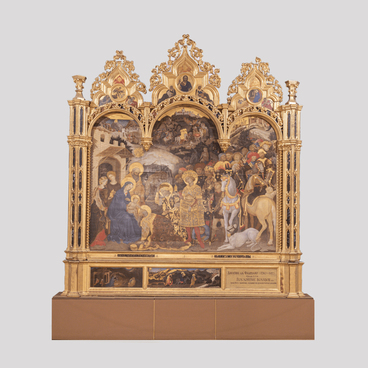This painting was created by an unknown artist. Most likely, it is a copy of the painting “Companions of Diana” that was created in 1745 by François Boucher and currently belongs to the Fine Arts Museums of San Francisco. The artist depicted a scene from classical mythology.
Jupiter, King of the Gods, fell in love with the nymph Callisto. Knowing that the nymph had taken a vow to remain a virgin and would reject him, Jupiter transformed himself into the figure of Diana. The nymph entrusted herself to Diana, and Jupiter seduced her. According to Ovid’s Metamorphoses, Callisto became pregnant with Jupiter’s child. As a result, Diana expelled her from her group which only included virgin women. Jupiter’s wife Juno became enraged with Callisto and turned her into a bear. Arcas, the son of Callisto and Jupiter, grew up a beautiful young man. When he went hunting for the first time, he encountered his mother, who was still a bear, and almost killed her. To avert the tragedy, Jupiter placed both Callisto and her son amongst the stars. Thus, they formed the constellations of Ursa Major and Minor.
The seduction of the nymph Callisto was first depicted as this erotic scene with two women in 18th-century France. During the Rococo period, art was permeated with images of beautiful women, luxury, and all sorts of pleasures. Myths, legends, and allegories were merely excuses to depict beautiful naked women and titillating scenes.
François Boucher, the court painter of King Louis XV, was commissioned to paint decorations for royal apartments at Versailles and the interior of the Royal Library. He created five paintings inspired by this myth, depicting various episodes of the meeting between Jupiter and Callisto. In one painting, Jupiter invites the nymph to join him, in another one he holds her in his arms, and the painting from the Voronezh Art Museum shows Callisto waking up.
François Boucher was a prominent representative of the Rococo aesthetics with its ornateness, elegance, and allegoric nature. The image of a tender porcelain-like female body with its light-pink color palette, the lush landscape with trees and flowers, the expensive shiny fabrics and furs, and the puffy clouds — all of these elements were combined to create an atmosphere of peace and prosperity.
Jupiter, King of the Gods, fell in love with the nymph Callisto. Knowing that the nymph had taken a vow to remain a virgin and would reject him, Jupiter transformed himself into the figure of Diana. The nymph entrusted herself to Diana, and Jupiter seduced her. According to Ovid’s Metamorphoses, Callisto became pregnant with Jupiter’s child. As a result, Diana expelled her from her group which only included virgin women. Jupiter’s wife Juno became enraged with Callisto and turned her into a bear. Arcas, the son of Callisto and Jupiter, grew up a beautiful young man. When he went hunting for the first time, he encountered his mother, who was still a bear, and almost killed her. To avert the tragedy, Jupiter placed both Callisto and her son amongst the stars. Thus, they formed the constellations of Ursa Major and Minor.
The seduction of the nymph Callisto was first depicted as this erotic scene with two women in 18th-century France. During the Rococo period, art was permeated with images of beautiful women, luxury, and all sorts of pleasures. Myths, legends, and allegories were merely excuses to depict beautiful naked women and titillating scenes.
François Boucher, the court painter of King Louis XV, was commissioned to paint decorations for royal apartments at Versailles and the interior of the Royal Library. He created five paintings inspired by this myth, depicting various episodes of the meeting between Jupiter and Callisto. In one painting, Jupiter invites the nymph to join him, in another one he holds her in his arms, and the painting from the Voronezh Art Museum shows Callisto waking up.
François Boucher was a prominent representative of the Rococo aesthetics with its ornateness, elegance, and allegoric nature. The image of a tender porcelain-like female body with its light-pink color palette, the lush landscape with trees and flowers, the expensive shiny fabrics and furs, and the puffy clouds — all of these elements were combined to create an atmosphere of peace and prosperity.



